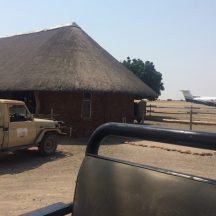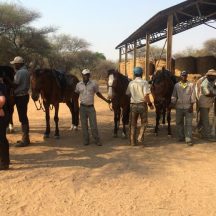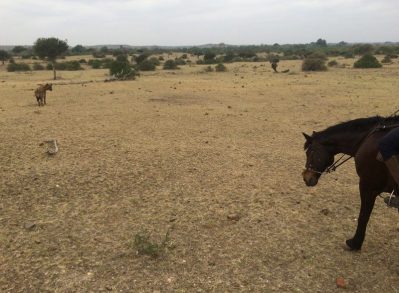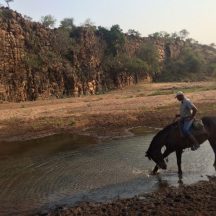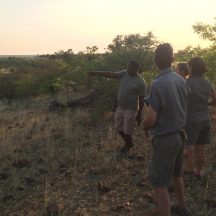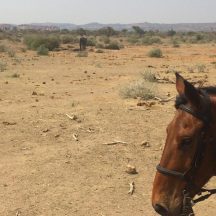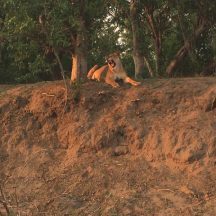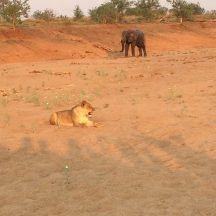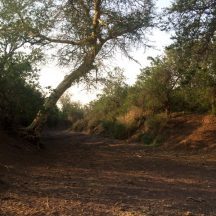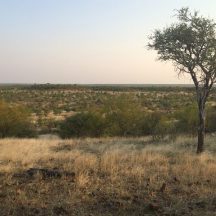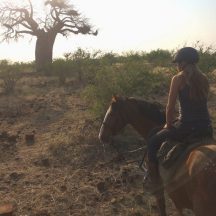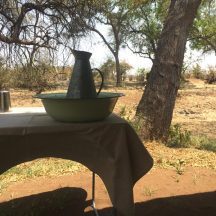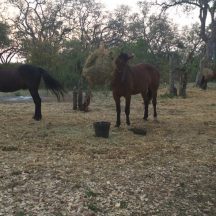The starting point for the Tuli Safari is right over Botswana’s border with South Africa, in the extreme east of the country, on the banks of the Limpopo River. The riverbeds were dry while I was there in October, but when the Limpopo is running, guests and supplies that arrive by road are shuttled across the mighty river in a cable car. You can also arrive in the reserve by plane to the small local airstrip, most convenient and also very atmospheric to go through the easy process of customs under the open airport’s thatched roof. However you reach base camp, you will be treated with the greatest hospitality upon arrival. We were given a cool drink and had the opportunity for a meal and to speak about our riding background so that the best match could be made with our mount for the week. As it was perhaps the hottest time of the year while I was there, it seemed unappealing to dress in the layers of riding clothing, even after the cool shower I took before getting ready. All lack of ambition quickly fled, however, when I got to the barn and saw the beautiful and fit horses ready and waiting to take us out.
- The local airport
- An unbeatable team of horses and grooms
The horses are a variety of breed, size, age and experience, from the imposing Shire/Thoroughbreds to my more compact Boerped mount. There were also Fresian, Warmblood and Paint crosses. All have been trained extensively on the flat and are well educated in dressage and also jumping. Many compete in eventing as well as going on safari, and it is a wonderful treat to ride such responsive and well-trained horses. Before heading out on the first ride each rider has a short test run – cantering a triangular shape away from the group and back again. It’s a great opportunity to be sure you are comfortable with your horse, and I was already impressed by how happily they all did this small piece of independent work. The daily riding was somewhat challenging, perhaps especially because of the heat when I was there, but the horses’ fitness was impressive after several days of 5-6 hours of riding, complete with long and steady canters. We also had the opportunity to jump on the trail, usually small logs of the mopane trees downed by elephants. As someone who simultaneously loves to jump and is also terrified of it, it was a huge pleasure to have the opportunity to ride such fabulously educated horses that made it easy and fun. My horse, Ajax, was also rock steady around all the game and hardly even flinched at the movement of nearby elephant or the unexpected flight of a bushpig.
And game we did see! Although it sounds like it may be an overstatement, it truly is not to say the experiences with wildlife were magical. On our first ride a seemingly endless group of elephants passed in front of us; a breathtaking introduction to what would become a common sighting. The next day we watched a cackle of hyenas near their den, neither they nor our horses apparently nervous to observe each other.
We crested a hill dotted with baboons to see zebra, giraffe, and wildebeest on the other side. Cantering through the mopane and acacia we were joined by zebra, and a lone wildebeest then continued to cavort just ahead of us. In the evening by game vehicle we found a single lioness watching an elephant at a water hole and later when darkness fell we found a family of cheetah by spot light.
We were utterly surrounded by animals in the otherwise completely empty wide open spaces dotted with mighty baobab trees and dramatic rock formations.
Given this environment replete with predators, I nevertheless always felt completely safe due to the careful professionalism of our guides and their backup team. West, the lead guide, and Tsoane, the backup guide, were both superb riders and game spotters. They were very knowledgeable of the flora and fauna of the area, and I loved learning about the pheromone defense mechanism of the mopane trees and the matriarchy of the hyenas. Soft spoken, yet with a commanding air of confidence, I would’ve felt comfortable following West anywhere, and did – by horseback, on foot and by vehicle. While they carried rifles, they told us that they had so far never had occasion to use them, but had in the past made good use of the bullwhips they also carried to threaten animals away. It was clear though that they preferred to not get into a position where such action was necessary, as they were constantly carefully evaluating our surroundings, even while the rest of us enjoyed sundowners, watching crocodiles disappear in their pool at the base of a tower of rock. At night someone from the team of grooms would always be keeping watch over the horses inside of protective electric fence, and guests were all escorted to their tents at the end of each evening.
- A drink and a scratch
- Our fabulous guide, West, imparting some knowledge during a walk
The tents and camps were very comfortable, and you get the chance to use several and thus see different country. There is a permanent camp where we spent several nights, complete with plumbed bathrooms and a pool for total comfort. The mobile fly camps are also comfortable – set up ahead of time by the camp team, so that all you need to do is leave a zipped bag in your camp and they take care of the rest, including setting up individual drop loos and a shared bucket shower. You spend two nights too in an open air camp, within the circle of a former tribal court under the shade of a large mashatu tree. This is also home to several families of vervet monkeys, who provide endless entertainment from the branches above you.

Our camp under the stars (and trees)
The Tuli safari operates in a wonderful location, giving us riders a varied experience with African wildlife. Additionally, the superb attention to detail regarding safety, the training of their horses, and the appointment of camps made the trip truly unforgettable.
- Elephants at a distance
- Yet another elephant in a water hole
- Lioness yawn
- An average day in Africa
- Riding through the rock formations
- In a riverbed
- Botswana view
- Rider and Baobab
- Full bathroom in camp
- Tribal camp
- View from my tent
- Horses enjoying a well deserved rest
By Megan Barrett


